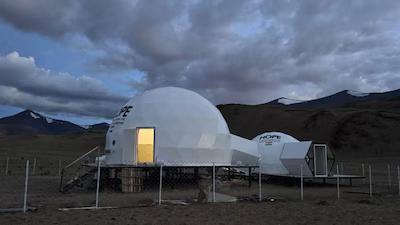
ISRO Sets Up Station in Ladakh to Simulate Life on Moon & Mars
The Indian Space Research Organisation (ISRO) has taken a significant step towards its ambitious plans to explore the Moon and Mars by setting up a unique station in Ladakh’s Tso Kar Valley. The Himalayan Outpost for Planetary Exploration (HOPE) is a 10-day simulation mission that aims to test life-support systems for lunar and Martian missions. The valley was chosen for its extreme environment, which is eerily similar to the Martian terrain.
Located at an altitude of 17,000 feet, the Tso Kar Valley is characterized by high UV radiation, low atmospheric pressure, extreme cold, and saline permafrost. These conditions are expected to challenge the crew members who will undertake various tests at the facility from August 1-10. The mission will provide valuable insights into how humans can adapt to the harsh environment of other planets.
The HOPE station is designed to simulate the conditions on the Moon and Mars, allowing scientists to test the equipment and procedures that will be used in future missions. The station is equipped with advanced life-support systems, including air, water, and food supplies, as well as communication equipment to maintain contact with the rest of the world.
The crew members who will participate in the simulation mission are trained astronauts who will spend 10 days at the facility. They will conduct a range of tests, including experiments on radiation protection, habitat design, and life support systems. The data collected during the mission will be used to refine the designs and procedures for future lunar and Martian missions.
ISRO has been working towards sending humans to the Moon and Mars in the near future. The HOPE station is a crucial step towards achieving this goal. The organization has already made significant strides in space exploration, including the successful launch of the Mangalyaan mission to Mars in 2013. However, sending humans to other planets poses unique challenges, including the need for reliable life-support systems and radiation protection.
The Tso Kar Valley was chosen for the HOPE station due to its unique environment, which is similar to the Martian terrain. The valley is characterized by extreme cold, with temperatures often dropping below -50 degrees Celsius. The low atmospheric pressure and high UV radiation also make it an ideal location for testing the equipment and procedures that will be used in future missions.
The HOPE station is a collaborative effort between ISRO and various Indian research institutions. The mission is seen as a major step towards India’s ambitious plans to explore the Moon and Mars. The data collected during the simulation mission will be used to refine the designs and procedures for future missions, including the upcoming Gaganyaan mission, which aims to send humans to space by 2022.
In conclusion, the ISRO’s HOPE station in Ladakh’s Tso Kar Valley is a significant step towards India’s ambitious plans to explore the Moon and Mars. The simulation mission will provide valuable insights into how humans can adapt to the harsh environment of other planets and will help refine the designs and procedures for future missions. The HOPE station is a testament to India’s growing capabilities in space exploration and its commitment to becoming a major player in the global space industry.
Source:






